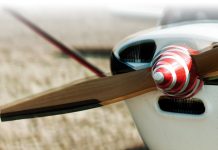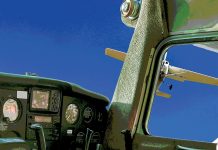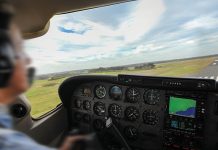By Warren Scanlon
This pilot had to make quick decisions after the airspeed indicator failed
Shortly after obtaining my private pilots’ licence, I hired a Warrior from a flying school at Moorabbin and had a holiday with my wife and daughter, flying to Sydney and Newcastle to visit family.
The total flying time was about 15 hours, which the manager of the school was pleased with, but explained the Warrior was wanted for training and suggested I use a Cessna 172 for future travel. So I did a conversion—one hour dual followed by a one-hour solo—then took my wife on a short trip to Phillip Island. Having logged about 10 hours on type, my wife and I flew in the Cessna to Corowa and were met by my brother-in-law who lived at Chiltern.
He requested a ride to have a look at his house so we took off and had an hour’s pleasant flight, then returned to Corowa, parked the aircraft and drove to Chiltern to meet his wife, who was pregnant. We stayed the night and next day my brother-in-law and his wife requested a flight before we departed back to Melbourne.
At the airport, I did all the checks and made sure my two passengers were sitting securely in the aircraft, all set for take-off. Okay, full throttle and head down the concrete runway, speed gradually building up, just about ready for rotation and lift off. A quick glance at the ASI—nothing! The ASI was not registering any reading! What to do? Should I abort? Not much room, so no—continue with the take-off and hope the blockage in the pitot tube will rectify itself.
We flew back to Chiltern and looked down on their farmhouse and then it was decision time—still no ASI reading and I was low hours on type. I was responsible for the safety of my passengers and there were no facilities at Corowa if I made a mess of the landing—and one of my passengers was seven months pregnant. No, better to divert to Albury.
‘Albury. This is Cessna Alpha Bravo Charlie*. Do you read?’
‘Alpha Bravo Charlie, this is Albury. We read you loud and clear.’
‘Albury, I have a problem with the ASI, no speed indication. Do you have ambulance and fire cart facilities on the airfield?’
‘Yes. We have facilities, leave it to me. What is your ETA?’
‘Thirty minutes’
‘Alpha Bravo Charlie, how many POB?’
‘Albury, three POB’
‘Roger, call on entering circuit area’
‘Alpha Bravo Charlie’
I informed the couple of my problem and advised them I intended to divert to Albury where I confirmed they had emergency staff in case of any mishaps with my landing. My passengers, far from being concerned, just thought this was an extra bit of excitement.
Having arrived over the top at 1500 feet, I was amazed to see many emergency vehicles—fire trucks, ambulances and TV vans—and a huge crowd of people, perhaps 300 all wanting to see me crash!
Okay, we are on finals and have done all the prelanding checks. A quick look at the ASI—still nothing. Just concentrate on flying, make sure you don’t stall, just keep up a bit of speed, try not to think of all the people watching. Instinctively I keep looking at the ASI—still nothing and rounding out coming up. Crosswind from the right, make a correction, stick back, not too much, you don’t want to balloon up … just keep the nose on the horizon, flying straight and level … hold it there, don’t get impatient, it will land itself.
Finally, we are over the threshold and I close the throttle and let the speed bleed off and finally we are safe on the ground. What a relief!
‘Alpha Bravo Charlie taxiing to parking area’
‘Alpha Bravo Charlie. Well done. Taxi to parking area and report to air traffic control’
We slowly taxi pass the crowd, which was now dispersing, no doubt disappointed at witnessing a normal landing. As we got out of the aircraft, one irate member of the crowd yelled out, ‘What a waste of taxpayers’ money, it probably cost us $30,000.’
I ignored the remarks and introduced myself to the airport manager and an amiable policeman who coordinated the emergency services. I also took a phone call from a jovial boffin from Regional Air Safety. ‘Nothing on the clock old boy!’
‘No sir.’
‘Well done. I don’t mind these incidents that have a happy ending, best of luck.’
Meanwhile a mechanic took the trouble to find the problem. Yes, it was a wasps’ nest in the pitot tube. He gave me a bill for his trouble: about $4000—country lads’ humour. When I got back to Melbourne, I sent him a cheque to buy some beer.
On reflection, the incident caused many emergency personnel to act. The senior policeman said two of his cars nearly collided in their haste to get to the airport, but conceded it was good practice. I suppose the hospital would have been notified and preparation made for burns victims. Fortunately, nothing drastic occurred.
When I arrived back at Melbourne, the manager of the flying school was noncommittal. Asked why he didn’t supply pitot head covers, he said, ‘People keep losing them and it’s too much trouble replacing them all the time.’
My mind went back to the irate bystander who reckoned I should pay for all the expense of the emergency exercise—perhaps send the bill to the school manager and he might may be more inclined to provide pitot-head covers in future because, sometimes, things go wrong.
* Aircraft callsign changed






I think I would have radioed someone for some advice, perhaps a relay call to my instructor because with some thoughtful reassurance, it was never going to be an emergency, assuming I’d been trained properly ! :)
Same thing happened to me twice in two consecutive flights whilst training for RPL doing solo circuits. I just flew by attitude and power settings. No dramas!
It wasn’t the managers fault. The wasps didn’t get there “in flight”. How could you get in an aircraft with “knowing the pitot was clear”. How could you leave the ground without knowing the “airspeed”
Power + Attitude = Performance.
How’s life on the ISS Neil?
Chances of having a nasty landing were low, however that`s easy for more experienced pilots to say. They likely have more understanding of how high they are by eyeballing the ground on route and in a circuit, and get a “feel” about the descent rate and final approach by listening to the engine revs, watching the engine revs and the attitude and altitude of the aircraft. The round out and landing is more’ natural’ to them but the pilot was in an unfamiliar plane.
Yes the pilot could/should have picked up the problem checking his speed for rotation on the take off run but I reckon a lot of us don`t do that religiously either and go by the rev`s developed check and our “feel” of speed down the strip.
The Pilot did what they thought was the best and safest options considering the number of PIC flying hours, hours on type and passengers. If they did crash or have a very hard damaging landing then the cost of the services would have been justified.
One of your checks on your take off roll is to ensure the ASI is alive. There are no circumstances when you should permit a take off with “nothing on the clock”. Had you been flying a twin you would have been in a very dangerous situation. Please slap yourself on the fore head and say “Duh!”.
I had the same problem with an Essendon based Cherokee 140 at Yarrawonga. 2pax damn hot day. ASI came up as normal to 40kts then stopped.
By the time I realised, it wasn’t working, I was barrelling down the runway but decided it was better to hit the fence at the other end than to take it into the air. Fortunately after an improvised (not real) ground loop, I managed to stop on the grass at the end without breaking the plane, in fact nil damage. Wasps 🐝 nest had compressed in the Pitot tube however initially dynamic pressure through to the ASI was possible.
I rang the flying school who knew the engineer up there and he fixed it and made me fly it straight away to check it. The flying school must have said get him back in the saddle as I was low hours at the time.
Lucky Yarrawonga has a long runway :-)
When I was in the Australian Air league, The instructors did checks of everyone, from least to greatest, it was great fun and kept you on your toes. Yep, One such check was a blank on the Pitot instruments, altimeter, ASI & VSI. We should all practice this stuff.
A common EFB (cheap insurance) on hand would have taken that pressure right off. The pax could of called out the speed bleed off during approach and landing. Or it can be maximised on screen and used like another instrument. Not perfect, but hey.
I’m surprised that you got far enough down the runway that you couldn’t initiate an aborted takeoff run. If your ASI isn’t working a few metres into the takeoff run, that’s a red flag.
As an avionics L.A.M.E. and changed many pitot probes, the probe inners can become corroded. A newly made partial nest can allow enough airflow to initiate an airspeed indication, especially if the wasp mud hangs up on internal pitot head corrosion. As the airspeed increases on the takeoff roll, its not improbable that new wasp mud can break up internally and totally block the pitot head, as the increasing airspeed can only force the mud one way-back into the pitot probe. I have, in the past had to really scrub pitot heads, so, to get an indication of airspeed on the takeoff roll and then lose it is not improbable. An old coat hanger is a great tool for poking up the pitot probe to clean wasp mud. Should be part of every preflight, especially out west. I always used the fuel drain probe on my pre-flights/inpections, every time.
The first thing that I do when I start my takeoff roll is “airspeed alive”,that applies to any aircraft that I operate,be it a light aircraft,or “Heavy Metal “.I have had to abort a take off a few years ago,when an Beech Kingair I was to ferry back to it’s home base in QLD,On takeoff from Bankstown,NO AIRSPEED INDICATION ,during the takeoff roll. Cause,the pitot tube opening was covered with sticky tape during the pre painting operation,and not removed after.I also agree with Walter,never ever poke anything into the pitot tube opening Have it checked by somebody that knows what they are doing.
I remember when our local aero club used to conduct various flying competitions. They might include flying a circuit under the hood (with an instructor in the right hand seat) or flying a circuit with a reduced instrument panel. One such competition involved covering the ASI (and one or two other instruments) so they were only visible to the instructor. The pilot had to rely on correct power settings and attitude during all phases of the circuit. Points were gained for the most accurately flown circuits. Several years later my ASI failed and I was faced with a landing without the instrument. Having already experienced landing without an ASI I felt confident in my ability to safely put the aircraft back on the ground. Aero club competitions were not only fun, but provided valuable lessons. The demise of clubs has sadly taken away this valuable form of training.
This happened to me once, But a mentor of mine taught me “power + Attitide -=Performance”: In my case the ASI was deviating from low to high IAS. All over the place. So I made the decision that the ASI could not be used as it was eratic. So my scan of instruments excluded it. I set power and maintained attitude to return for an incident free landing.